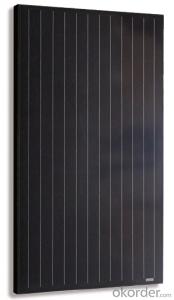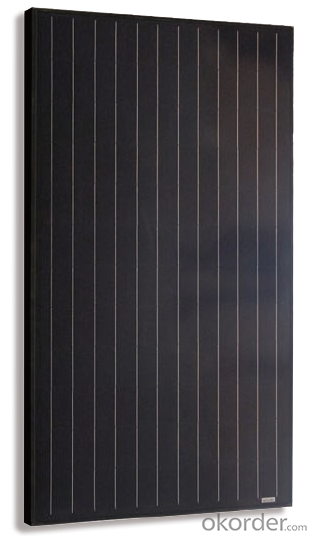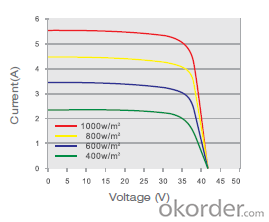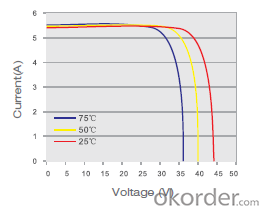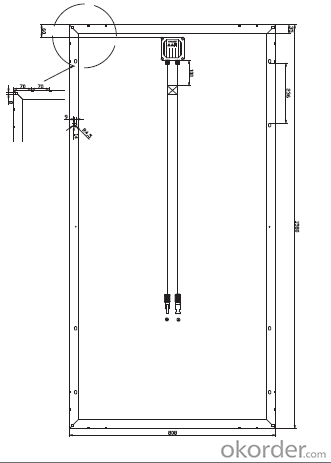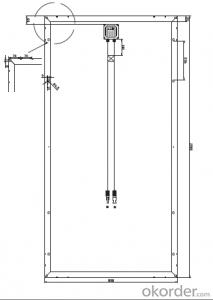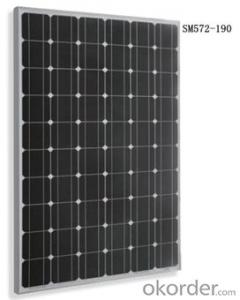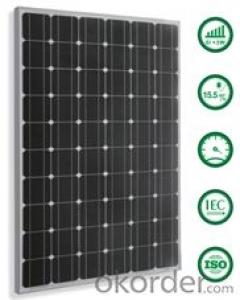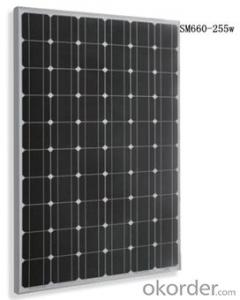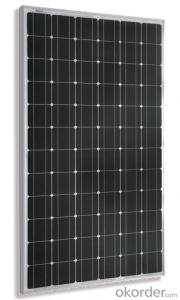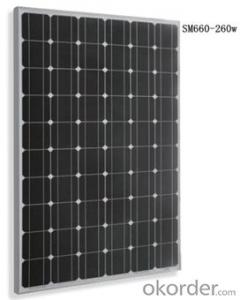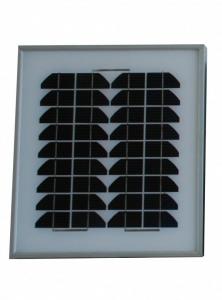Solar Panels Nd Monocrystalline Solar Module Black SM572-195
- Loading Port:
- Shanghai
- Payment Terms:
- TT OR LC
- Min Order Qty:
- 25 set
- Supply Capability:
- 8000 set/month
OKorder Service Pledge
OKorder Financial Service
You Might Also Like
Product Description:
1.Structure of Monocrystalline Solar Module SM572 195WSeries Description:
Monocrystalline Solar Module SM572 195W: High efficiency crystalline solar cell. Even if under the weak light, the solar module can produce maximum power output.
II Tempered glass (toughened glass): Anti-reflecting coating and high transmission rate glass increase the power output and mechanical strength of solar module.
III EVA and TPT: Using high quality EVA and TPT to prevent destroying and water.
IV AI frame: Without screw, rner connection. 6 holes on the frame can be installed easily.
V Junction box: Multi function junction box with water proof.
VI Long lifetime: ≥25 years; Less power decrease.
VII Good performance of preventing from atrocious weather such as wind and hails.
VIII Resisting moisture and etching effectively, not effected by geology.
IX The certificate issued by international authority: TUV, IEC, CE.ISO9001.MCS
2. Standard Test Conditions of Monocrystalline Silicon Solar Panel:
The opto-electrical specifications shown below are stabilized values being measured at Standard Test Conditions, Irradiance: 1000W/m2, Spectrum: AM1.5 at 25°C, The info below is subject to manufacturing tolerances. Where appropriate minutes of measurement are available and are used for the dimensioning of the installation.
Advantages of Polycrystalline Silicon Solar Panel
• 25 year transferrable power output warranty: 10 years / 90%, 25 years / 80%*
• 12 year material and workmanship warranty
• Timeliness of delivery
• Quality Products certified (TUV, IEC, CE.ISO9001.MCS)
3. Characteristics of Monocrystalline Silicon Solar Panel:
• Guaranteed tolerance +3%
• High manufacture standards
• Reliable power output
• High module efficiency
• Module efficiency up to 15.5%
• Cells efficiency up to 17.6%
• Strong compressive strength
• Certified to withstand high wind of 2400Pa
4. Solar Panel Images
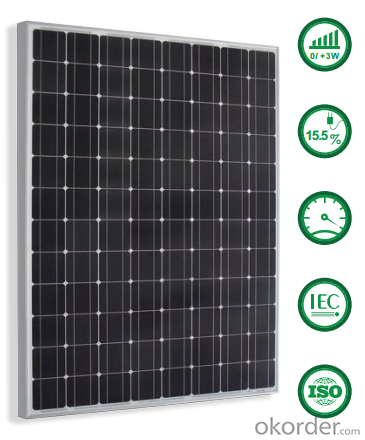
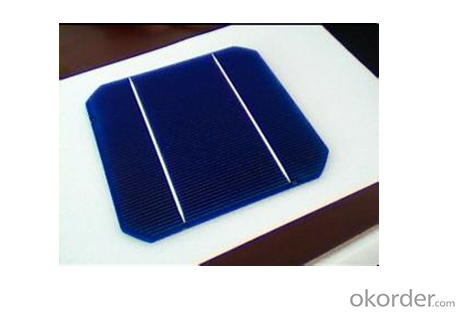


5. Monocrystalline Silicon Solar Panel Specification
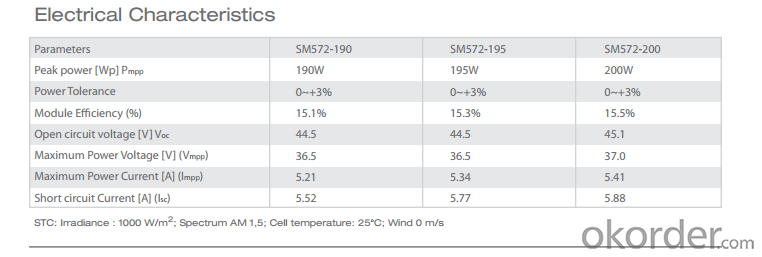
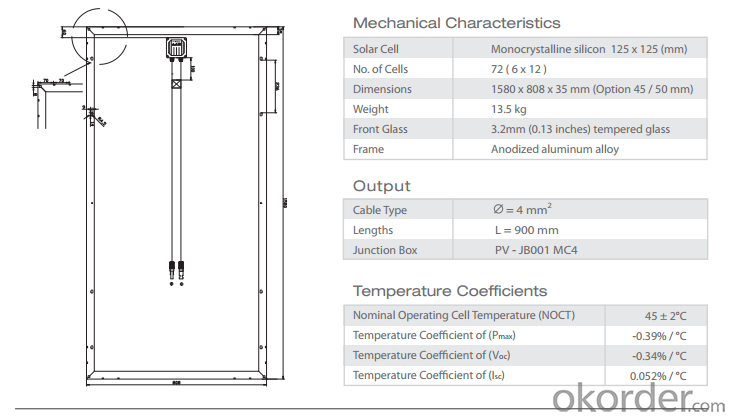


6.FAQ
We have organized several common questions for our clients,may help you sincerely:
①How about your company?
We are a private-owned high-tech company who specializes in developing, manufacturing and marketing of silicon ingots, solar wafer, solar cells, solar modules, PV systems and solar applications products.
At present, We has one research & development team, whose members are well-known experts in photovoltaic area. We also have advanced production and test equipment.
②How to guarantee the quality of the products?
Our products have been certified by CE, CEC,MCS, IEC61215, IEC61730 and ISO9001.
• 25 year transferrable power output warranty: 10 years / 90%, 25 years / 80%*
• 12 year material and workmanship warranty
• Timeliness of delivery
• Quality Products certified (TUV, IEC, CE.ISO9001.MCS)
③How long can we receive the product after purchase?
In the purchase of product within three working days, We will arrange the factory delivery as soon as possible. The pecific time of receiving is related to the state and position of customers.Commonly 7 to 10 working days can be served.
- Q: I know that if I put solar panels in my home I will get 30% back from the govt. Does that mean if I pay 2K I will get back around a 3K check? Or will my income play a roll where I may not get back as much?
- The Tax Lady is almost always right, but I must disagree on the $500 limitation concerning a solar electric system (from the price, it sounds like that's what the original question was about) installed in 20. If there was such a change, there would have been an outcry on the solar installers' forum I visit, just as there was jubilation when the limit on the tax credit was removed a few years ago.
- Q: Is it really possible for me living in Denver to build and install and setup my own solar panel to help make electricity for my home?
- I honestly don't know but I have done lots of internet searches and there are several site where you can buy the plans to do this for around $49 and in the blurb it says that the hardware is very cheap to buy too. These are american based sites saying that all the hardware is easily available so why not give it a try though it could all be a con - $49 dollars might be worth a try
- Q: Can solar panels be used in areas with high levels of rainfall?
- Yes, solar panels can be used in areas with high levels of rainfall. While rainfall may temporarily reduce the amount of sunlight reaching the panels, modern solar panels are designed to efficiently capture and convert even diffuse light. Additionally, regular rainfall can help keep the panels clean, improving their overall performance.
- Q: I thought they were going to make solar powered cars and solar power plants among other things. It was only nearly 0 years ago that solar power was the big thing. Just curious, why did it die out?
- I saw a commercial the other night for a fan you hook onto the top of your car window, and it's solar-powered. (supposedly cools off your car while gone...as opposed to just cracking the windows some). Also, I've seen traffic lights and emergency beacons on the highway powered by solar panels.
- Q: Hi, wanting to set up the most basic solar panel system for a cabin in the woods that has enough power to recharge four 2V car batteries during the daytime (i am assuming; we want to run a mini fridge maybe a stove and a few lights at night off the batteries and be able to run it all just off solar during the day) It also needs to be able to power some simple tools during the day... Experience would be absolutely amazing since alot of the info on solar paneling is either really dumbed down, or ridiculously confusing.As of right now I am looking at a 3 panel (45watt in all) solar kit that needs a 300w inverter.... is this sufficient for my power needs? I am just a little perplexed, thanks so much!
- That okorder /... , but expect to pay several thousand dollars for something that actually works. If you just want to use the place for intermittent getaways, a generator may be sufficient, and you can skip the solar panels. If you intend to live in the place, then consider getting a system that is at least 500-000 watts of panels, and a 000 amp-hour or more battery bank.
- Q: I'm doing a science fair experiment with a tiny two-inch solar panel that only gives off like .5 volts of energy, but I need to know how many volts an average sized solar panel (like one you'd get to run your house) would produce. And how many panels do people usually get?
- 2 volt and 24 volt are both common sizes. They are rated in voltage and watts. So you add the watts of the panels and buy enough to produce the amount of watts you need. For example, if you need 400 watts of power at 2 volts, you would buy four 00 watt 2 volt panels and connect them in parallel.
- Q: Okay, I think I understand what I'm doing, but I want to set up some solar panels on the roof of my garage, the building that gets the most sun, and I want to make sure all my math is correct in determining number of megawatts per year. However, my knowledge of electrical terms in quite n00bish, to say the least.Here is what I think I should be doing.The solar cells come at .75 Watts average power.I will install 4 panels of 64 cells each, with a total of 256 cells.
- For comparison, 36 of these make a normal 2V x 50W panel. Note they are not tabbed. This means you have to find a way to connect them yourself. The tabs are probably spot welded on by the suppliers. A supplier below has kits of these with tabs, as needed to connect them together. These are not suitable for grid connect, because the higher voltage needed makes do it yourself panels a dangerous and litigious thing to have on your roof. Maybe you could buy a smaller pack from the link below to compare tabbed and untabbed and work out what to do. Your power calculation is a bit incorrect because the sun is only present some of the time. The 36 cell module would produce 50W when square on to the full sun. The sun may be out for around 2h a day in some places and times of the year. However it is the equivalent of 5h full sun, because of the changing angle throughout the day. Look this up on the internet for your region. Temperate zones may be a lot less. One pack in your link is 36x3 = 08 cells. Thus 50W per pack x 5h a day gives 750Wh per day and 274KWh/y. In reality it will always be less because of regions, weather, clouds, dust, inefficiencies, aging of cells.
- Q: How are solar panels installed?
- Solar panels are typically installed on rooftops or open spaces using metal frames or mounting brackets. The process involves anchoring the panels securely, connecting them in a series or parallel configuration, and wiring them to an inverter that converts the DC electricity generated by the panels into usable AC electricity. Additionally, a solar panel installation may require making electrical connections to the building's electrical system and installing a net meter to measure the energy produced and consumed.
- Q: i'm talking abt bulk panelling, how many MW do we get from km sq?
- As okorder / They are working on a reactor that makes diesel and electricity concurrently out of coal, biomass or possibly garbage in a non-polluting process.
- Q: Can solar panels be used to power a museum?
- Yes, solar panels can be used to power a museum. Solar panels convert sunlight into electricity, which can then be used to power various electrical systems and devices within the museum. The installation of solar panels on the museum's roof or surrounding areas can generate renewable energy, reducing the reliance on traditional energy sources and lowering carbon emissions. Additionally, solar power systems can provide a sustainable and cost-effective solution for powering a museum's lighting, climate control systems, and other electrical needs.
Send your message to us
Solar Panels Nd Monocrystalline Solar Module Black SM572-195
- Loading Port:
- Shanghai
- Payment Terms:
- TT OR LC
- Min Order Qty:
- 25 set
- Supply Capability:
- 8000 set/month
OKorder Service Pledge
OKorder Financial Service
Similar products
Hot products
Hot Searches
Related keywords
